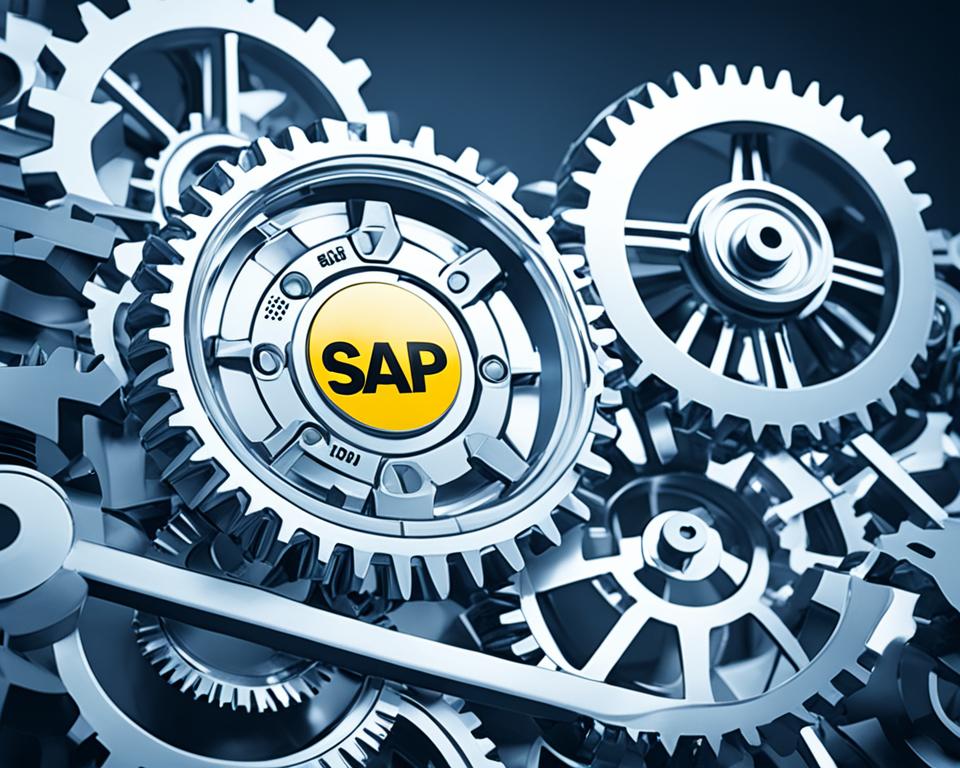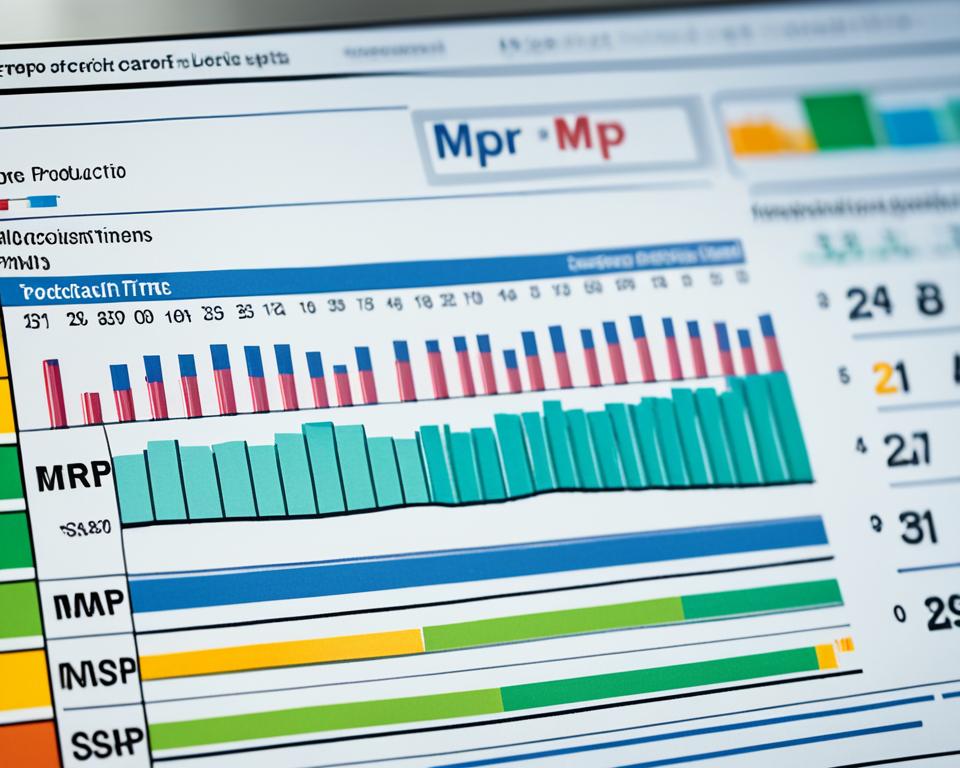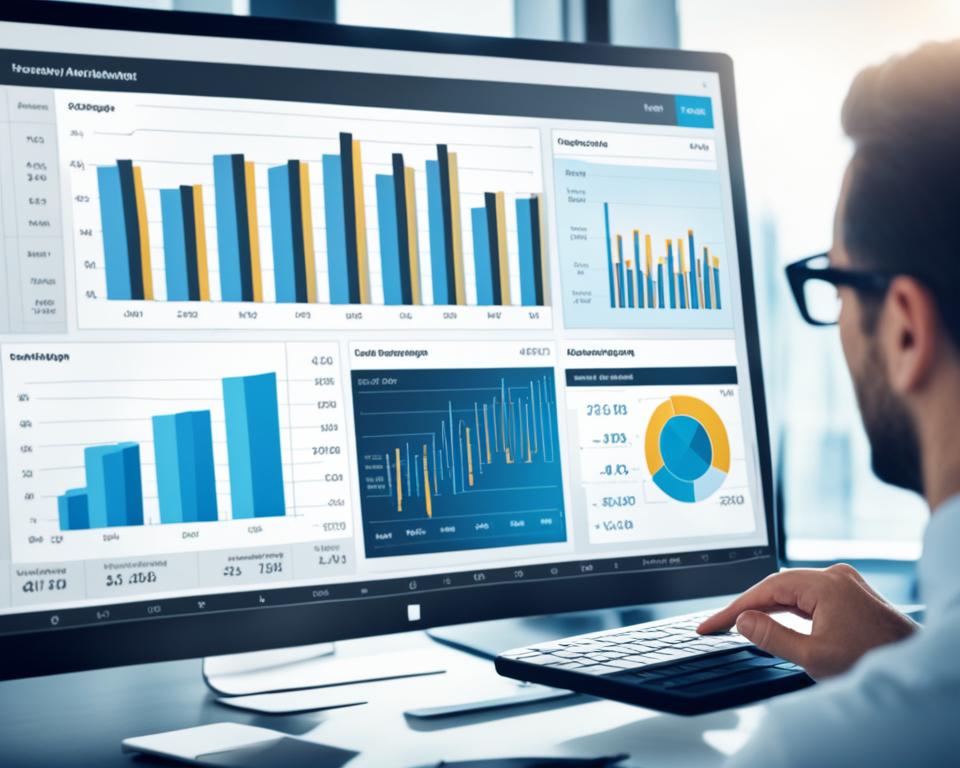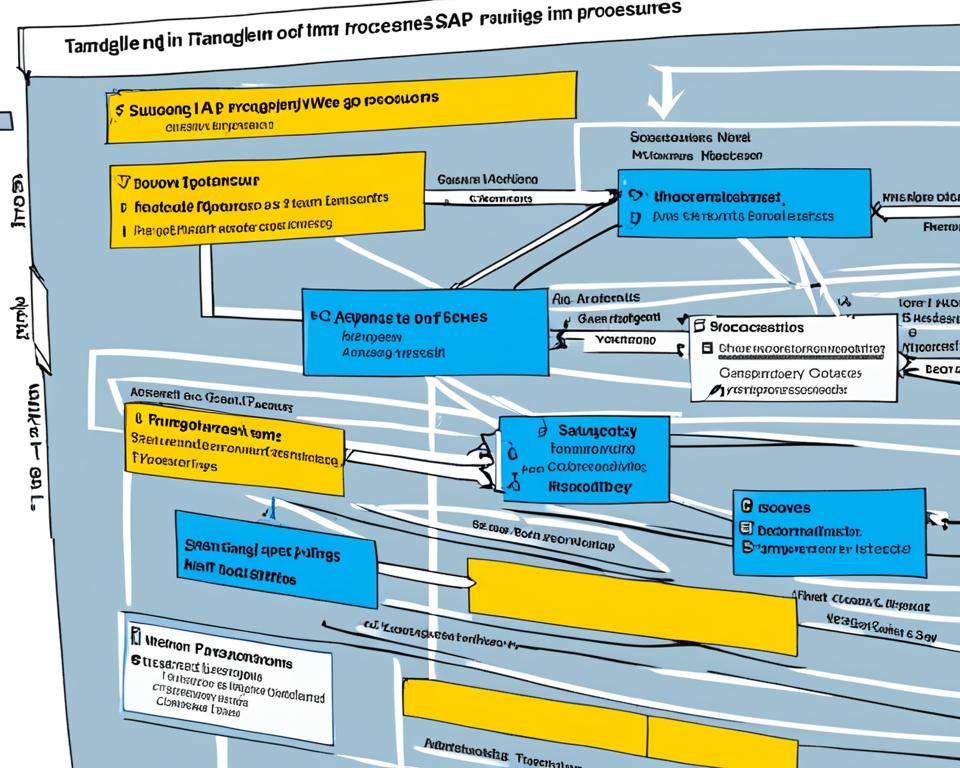Ever wondered how companies make their supply chain run smoothly while handling lots of materials? SAP MM (Materials Management) is key in ERP systems. It helps with managing materials, making operations more efficient and cutting costs. Let’s explore how SAP MM’s parts, like procurement and inventory management, are crucial for better materials handling. These are must-knows for any business wanting to stay ahead.
SAP MM gives companies the tools to manage their inventory well, improve how they buy materials, and make their supply chains more efficient. By adding materials management to ERP systems, businesses can work better and more accurately.
Want to learn more about SAP’s role in business solutions? Check out this deep dive into SAP and ABAP.
Key Takeaways
- SAP MM is key for managing materials well in ERP systems.
- Improving how you buy materials makes supply chains more efficient.
- Tracking inventory in real-time helps in making better decisions.
- Choosing the right way to value materials aids in accurate financial reports.
- Linking SAP MM with other modules makes operations better.
- Always looking to improve processes cuts costs.
Understanding Materials Management in ERP
In today’s fast-paced business world, managing materials is key in ERP systems. It means planning, controlling, and watching materials from start to finish. Knowing how to manage materials well is crucial for having the right stuff on time and cutting down on waste.
Let’s look at how important managing materials is for getting things done. Good management makes getting materials easy, helping businesses quickly meet customer needs. This makes things run smoother and cuts down on delays.
Keeping an eye on inventory is also vital in managing materials. It makes sure there’s just the right amount of stock. This balance helps with production and keeps storage costs low. By focusing on this, companies can work better and save money.
Managing materials well is key to a business’s success. A strong plan in an ERP system uses resources wisely, saves money, and makes customers happier.
| Key Element | Description |
|---|---|
| Procurement Processes | Streamlines the acquisition of materials, ensuring efficient ordering and timely delivery. |
| Inventory Control | Maintains optimal inventory levels to meet production requirements and avoid excess costs. |
| Resource Utilization | Enhances the effective use of materials and resources, driving operational efficiency. |
| Cost Management | Aims to reduce costs associated with procurement and inventory management. |
Overview of SAP MM and Its Significance
SAP MM is key in the world of materials management. It helps improve supply chain efficiency with its many features. These features help manage inventory, procurement, and planning for materials. It shows how SAP MM helps keep stock levels just right.
SAP MM makes buying materials more efficient, cutting down on costs. It helps keep products in stock for customers. This leads to better service and happier customers, giving a business an edge in the market.
Using SAP MM, companies can cut waste and use resources better. This makes managing materials more sustainable. Here are the main benefits of SAP MM:
- Enhanced monitoring of inventory levels
- Reduced lead times in procurement
- Improved accuracy in inventory valuation
- Integration with other SAP modules for a unified ERP experience

In summary, SAP MM plays a big role in managing supply chains. It makes things more efficient and helps businesses respond quickly to changes in the market.
| Feature | Benefit |
|---|---|
| Real-time Inventory Tracking | Ensures accurate stock levels and minimizes excess inventory |
| Automated Procurement Processes | Reduces the time and effort involved in sourcing materials |
| Material Requirements Planning | Aids in forecasting material needs, preventing shortages |
| Supplier Management Tools | Enhances relationships and negotiations with suppliers |
Key Components of SAP MM
Understanding SAP MM’s key components is vital for managing materials well. I’ll look into procurement, inventory management, and material valuation. These are key to a strong framework for businesses.
Procurement Processes
Procurement in SAP MM is crucial for a smooth supply chain. It includes picking vendors, making purchase orders, and managing contracts. Doing these tasks well cuts down on wait times and improves supplier relationships.
Automating these steps saves a lot of time. For more tips on making procurement better, check out this resource.
Inventory Management Features
Managing inventory is a big part of SAP MM. It uses advanced tools to keep stock levels just right. I keep an eye on inventory with detailed reports and automated orders.
This keeps materials in stock without wasting money. Real-time tracking helps me quickly adapt to demand changes.
Material Valuation Methods
Choosing the right way to value materials is key for good financial reports and inventory control. SAP MM offers methods like FIFO, LIFO, and moving average. Each method fits different financial plans and affects how we see material costs.
Using the right method helps in making smart procurement and inventory decisions.
| Material Valuation Method | Description | Impact on Financial Reporting |
|---|---|---|
| FIFO | First items purchased are the first to be sold. | Can lead to lower cost of goods sold in inflationary periods. |
| LIFO | Last items purchased are the first to be sold. | Can lead to higher cost of goods sold in inflationary periods. |
| Moving Average | Averages the cost of materials over time. | Provides a more consistent view of material costs. |
Knowing these SAP MM components helps me make better decisions for managing materials.
SAP MM: Streamlining Procurement Operations
SAP MM procurement operations are key to making things run better in companies. They automate many tasks in the procurement process. This means less manual work, fewer mistakes, and faster buying.
Working with SAP MM also makes talking to suppliers easier and quicker. This leads to faster order processing. With these tools, I can negotiate better deals, saving money. SAP MM makes buying things more efficient and smooth.
Effective Inventory Management Strategies in SAP MM
Using SAP MM for inventory management can make a big difference in business efficiency. Real-time tracking of inventory gives a clear view of stock levels. This helps businesses make quick decisions and adapt to changes in demand and supply.
Real-time Inventory Tracking
Real-time inventory tracking changes how companies handle their stock. It lets businesses keep an eye on inventory levels all the time. This lowers the chance of running out of stock and reduces costs from holding too much inventory.
With SAP MM’s tracking tools, companies get a clear view of their inventory. This helps them make smart choices that boost their financial health.
Stock Management Techniques
Using the right stock management techniques is key to improving inventory turnover. Methods like ABC classification, just-in-time, and cycle counting are very important. They help focus resources and make sure the right products are available when needed.
- ABC Classification: This method sorts inventory into three groups (A, B, C) by value. It helps manage high-value items better.
- Just-in-Time Methodology: This approach aims to lower inventory by getting goods only when needed. It helps improve cash flow.
- Cycle Counting: This involves counting a part of the inventory regularly. It keeps inventory accurate and cuts down on errors.
For more details on how procurement fits with these inventory strategies, check out this resource. Using these strategies in SAP MM makes operations smoother and gets businesses ready for growth.
| Technique | Description | Benefits |
|---|---|---|
| ABC Classification | Segments inventory based on value | Improves focus on high-value items |
| Just-in-Time | Reduces inventory levels by timing purchases | Enhances cash flow management |
| Cycle Counting | Regularly verifies portions of inventory | Maintains accuracy and reduces discrepancies |
Material Requirements Planning (MRP) in SAP MM
In the world of material requirements planning, MRP SAP MM is key for businesses to improve their supply chain. It helps predict what materials are needed, keeping stock levels just right. This tool helps avoid running out of stock and reduces the costs of having too much inventory, making operations more efficient.
MRP in SAP MM starts with understanding what customers want and leads to better buying processes. It keeps an eye on stock levels, telling me when I need to order more. This way, I can optimize inventory and meet customer needs without delays.
MRP also connects well with other SAP modules. This sharing of information makes it easier to plan for the future. It turns messy inventory management into a smooth operation.
Using tools like the ABAP Development Environment, I can make material planning even better. It helps with debugging and improving performance. Overall, MRP in SAP MM gives a big edge to companies aiming for top-notch material and procurement management.

Understanding Goods Movement in SAP MM
Goods movement is key in SAP MM’s material management. It includes goods receipts, goods issues, and inventory transfers. These actions are vital for keeping inventory accurate and meeting company standards.
Let’s look at the main types of goods movement:
- Goods Receipts: This process tracks when goods arrive, helping to keep inventory and value correct.
- Goods Issues: It’s about taking materials out of inventory for use. This helps show how much stock is left.
- Inventory Transfers: These moves goods between storage spots, updating stock levels right.
Keeping track of each goods movement is crucial for inventory accuracy and following the rules. Without good tracking, companies might lose track of their materials. Good movement processes make material management in SAP MM better. They help companies work well and reach their goals.
The Role of Purchasing in SAP MM
The purchasing function is key in SAP MM, making procurement more efficient. It’s important to manage purchase orders and supplier relationships well. This helps businesses run better.
Creating Purchase Orders Easily
SAP MM makes creating purchase orders easy. It automates many steps, making procurement quick and efficient. Automated workflows speed up approvals, helping make timely decisions.
This ensures businesses keep a close eye on their inventory and procurement. It’s all about making sure things run smoothly.
Supplier Management
Managing suppliers well is crucial for strong partnerships. In SAP MM, tools help evaluate and track supplier performance. This leads to better communication and teamwork with suppliers.
This approach to managing suppliers makes partnerships stronger. It helps keep materials flowing well, which is key in complex supply chains. For better procurement, using SAP Ariba modules can be really helpful.

Integrating SAP MM with Supply Chain Management
Adding SAP MM to supply chain management is key to better operations. It helps streamline processes and makes sure all parts of the supply chain work well together.
SAP MM is a key tool for managing supply chain tasks. It helps departments talk better, making procurement, inventory, and logistics work smoother. This leads to big benefits from working together with supply chain partners.
When SAP MM is well integrated, it helps end silos between different teams. This creates a culture of teamwork. Such a culture leads to more innovation and quick responses, which are vital for today’s supply chain needs.
Using SAP MM also means sharing data in real-time and reporting better. Improving reporting in SAP MM helps in making better decisions and managing the supply chain proactively.
The table below shows the main benefits of combining SAP MM with supply chain management:
| Benefit | Description |
|---|---|
| Improved Visibility | More insight into inventory and procurement. |
| Enhanced Communication | Better teamwork among departments and partners. |
| Increased Efficiency | Processes run smoother, cutting down time and costs. |
| Agility | Quick response to market shifts and customer needs. |
| Data-Driven Decisions | Using analytics for smarter choices. |
In conclusion, SAP MM integration in supply chain management leads to a complete approach. It lets companies use their supply chains fully for better performance.
Enhancing Decision-Making with SAP MM Analytics
SAP MM analytics is key for professionals wanting to make their processes better. It helps businesses make decisions based on data, which can greatly improve how they work. By looking at procurement data and inventory rates, companies can find ways to work more efficiently.
In SAP MM, there are tools that give deep insights into materials management. These tools let me find ways to save money and boost productivity. This helps me make smart choices that fit both what we’re doing now and what we want to achieve in the future.
To use SAP MM analytics well, I need to know what it offers. I often look at dashboards that show important performance numbers. These numbers are key because they track trends and see how we’re doing against our goals.
Below is a table showing the main parts of SAP MM analytics for making decisions:
| Feature | Description | Benefits |
|---|---|---|
| Real-Time Data Analysis | Access to live data for immediate insights. | Facilitates quick responses to changing conditions. |
| Supplier Performance Tracking | Evaluates supplier reliability and relationships. | Enhances procurement efficiency and negotiation strategies. |
| Inventory Turnover Insights | Measures how quickly inventory is sold or used. | Helps maintain optimal stock levels and reduce holding costs. |
| Cost Analysis Tools | Breaks down costs associated with procurement and inventory. | Enables identification of cost-saving opportunities. |
Using these analytics, I learn how to work more efficiently and align my materials management with the company’s goals. Being able to turn data into actions is key for success and staying strong over time.

Best Practices for Implementing SAP MM
Starting SAP MM needs careful planning and following best practices. Begin with detailed business process mapping. This helps tailor SAP MM to your company’s needs. It makes processes smoother, aiming to boost efficiency.
Good change management is key when moving to SAP MM. Include stakeholders early and be open about changes. This builds a supportive environment for teams to learn new systems and workflows.
Don’t forget about staff training. Make training match the software’s real-world uses. This makes users more comfortable and lets them use SAP MM fully. It greatly helps in making things more efficient.
After starting, keep improving with continuous improvement initiatives. Regular checks and updates keep the system strong and in line with company goals. This ongoing process keeps SAP MM effective and prepares the company for new market needs.
Common Challenges in Using SAP MM
Implementing SAP MM offers big benefits, but it also has challenges. It’s important to know these challenges to use materials management fully.
One big issue is integrating SAP MM with other systems. If it doesn’t connect well, it can cause data to be in separate places. This makes processes harder and slows things down. Companies often struggle with managing materials because of this, leading to wrong inventory levels and problems with buying things.
Another challenge is getting staff to accept the change. People used to doing things a certain way might not like the new system. This is often because they don’t know how it helps or haven’t been trained on it. This leads to not using SAP MM well.
Also, data quality is a big problem. Bad data can make SAP MM not work right, which affects making decisions and managing materials. This happens when data isn’t entered correctly or not updated regularly.
To fix these issues, there are steps to take:
- Invest in training to help staff adjust and get excited about the system.
- Use tools to make sure SAP MM connects well with other systems, improving data flow and accuracy.
- Put in place strict rules for data to keep it reliable and accurate.
Knowing and dealing with these challenges is key for companies to make SAP MM work well.

Conclusion
In this SAP MM review, we looked at the key parts of materials management. We saw how it affects procurement and supply chain efficiency. SAP MM’s strong features make operations smoother and help in making better decisions. This lets businesses quickly adjust to market changes.
For companies wanting to improve their materials management, using SAP MM is key. It offers tools for tracking inventory in real-time and managing suppliers well. This helps businesses run better and be more competitive.
I suggest that companies explore SAP MM’s full potential. Getting to know its features can lead to better processes and outcomes. For more knowledge, checking out resources on related topics is a good idea. A great place to start is an insightful guide on ABAP Object-Oriented Programming. It can improve how you develop in SAP environments.



Leave a Reply